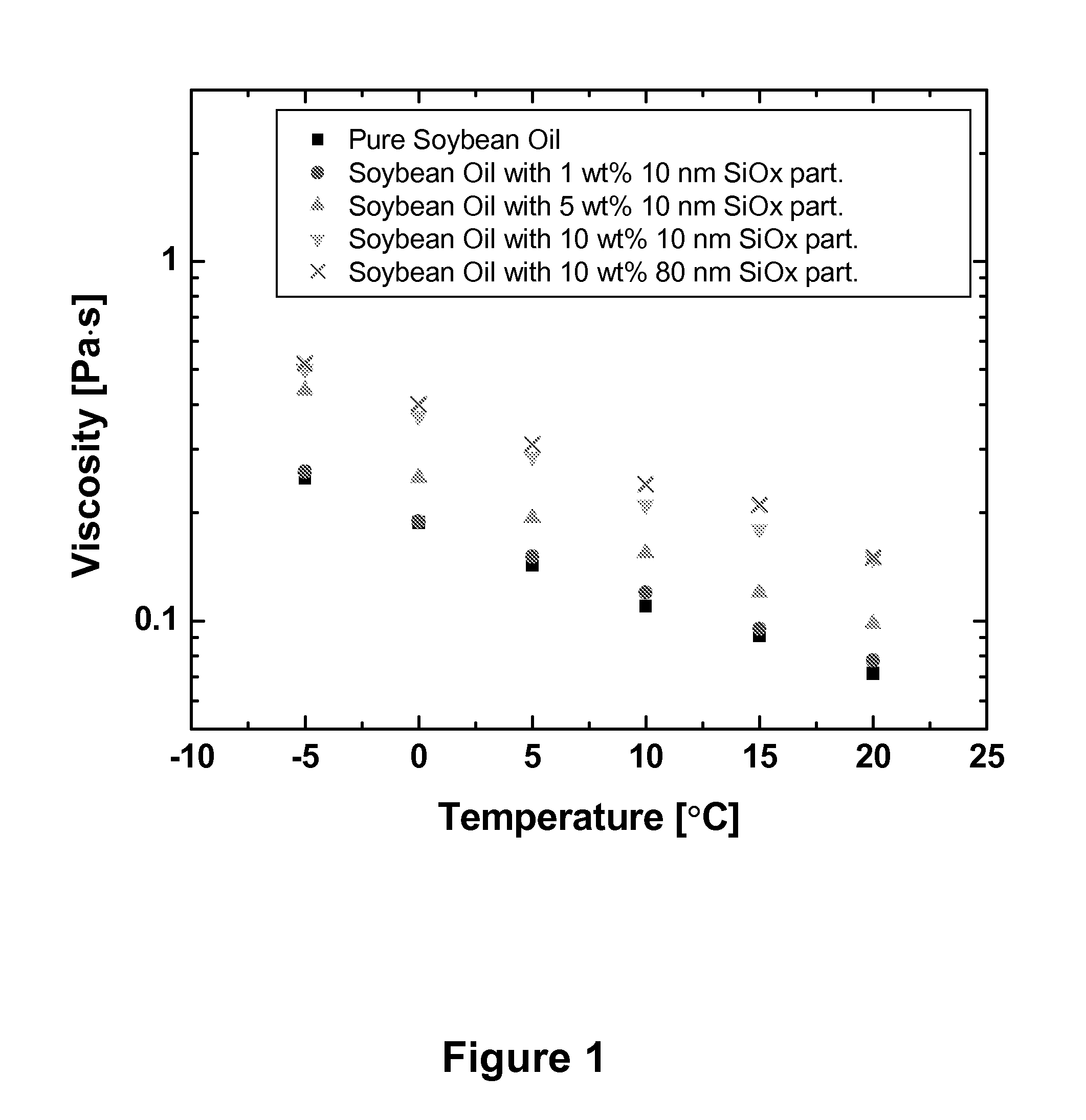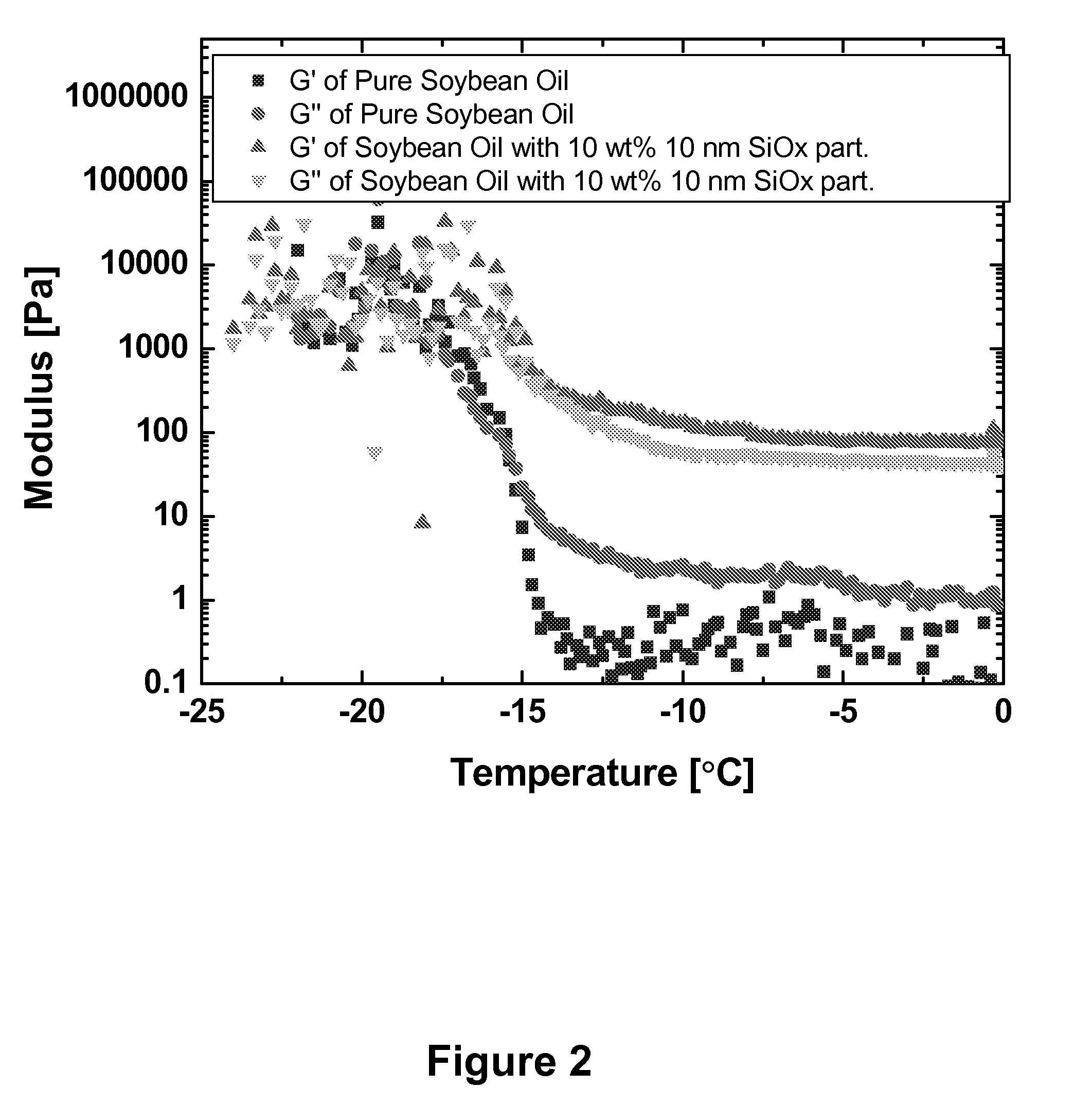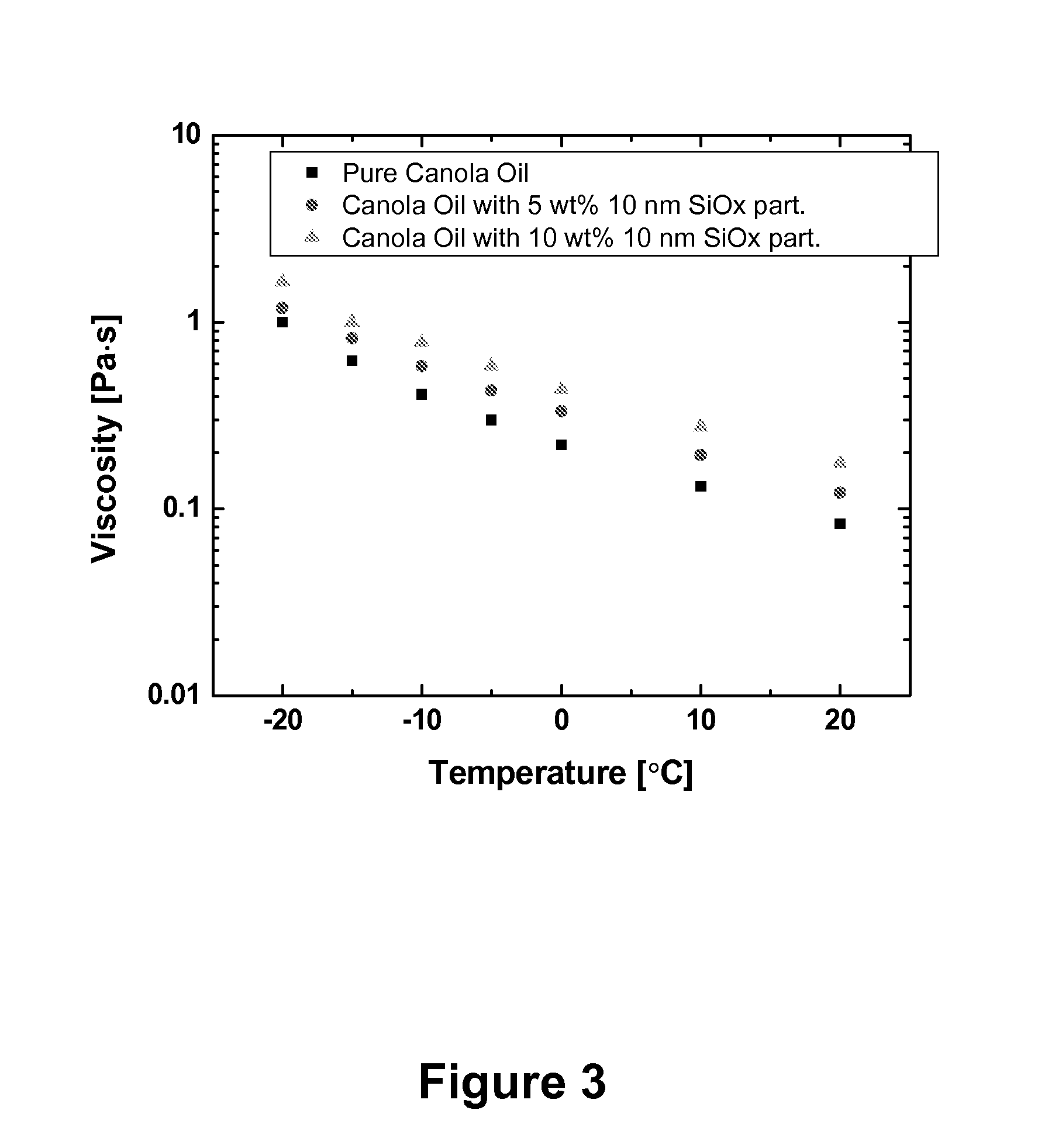[0014]Incorporation of nanoparticles in the present compositions is beneficial for providing mechanical, thermal, optical and / or chemical properties useful for a selected product or product application. In some compositions of the present invention, for example, incorporation of the
nanoparticle component provides compositions derived from one or more vegetable oils exhibiting enhanced
mechanical stability,
hardness,
viscosity,
thermal stability and
mechanical strength. In some compositions of the present invention, for example, incorporation of the
nanoparticle component provides
wax compositions having enhanced optical properties relevant to
exposure of the wax to light, such as
ultraviolet light, relative to conventional waxes.
Nanoparticle components of some aspects of the present invention have physical properties (e.g., morphology, physical dimensions, size distribution etc.), chemical properties (e.g. composition) and interfacial characteristics that give rise to intermolecular interactions providing a molecular scale arrangement of the
nanocomposite material resulting in useful bulk phase mechanical and / or chemical properties. The invention includes products and articles of manufacture comprising the
vegetable oil derived materials having dispersed nanoparticles providing enhanced physical and chemical properties.
[0016]In an aspect, the present invention provides a wax containing composition comprising: a synthetic wax derived from one or more vegetable oils; and a plurality of nanoparticles dispersed in the synthetic wax. In an embodiment of this aspect, the dispersed nanoparticles have an average cross-sectional dimension selected from the range of about 1 nanometer to about 100 nanometers and the nanoparticles comprise between about 1% and about 50% by
mass of the composition. Optionally, the wax containing composition of this embodiment may further comprise one or more additional additives, including, but not limited to, dispersants and / or stabilizers to enhance overall
mechanical stability,
thermal stability and / or
shelf life. For example, compositions of the present invention may further comprise one or more surfactants for reducing or minimizing nanoparticle coagulation and / or
settling. Other additives useful in the present compositions include one or more of suspension agents, a colorant, a fragrance and an emulsifying agent.
[0017]Synthetic waxes useful in this aspect of the present invention include, but are not limited to,
triglyceride-based waxes derived from
natural oils. In an embodiment, for example, a wax of the present invention comprises a
triglyceride component that is greater than or equal to 20% by
mass of the composition. Preferably for some applications a wax of the present invention comprises a
triglyceride component having a concentration selected from the range of 20% to 80% by
mass of the composition, and more preferably for some applications a triglyceride component having a concentration selected from the range of 20% to 50% by mass of the composition.
Triglyceride-based waxes useful for certain compositions of the present invention comprise one or more hydrogenated or nonhydrogenated vegetable oils or are derived from one or more hydrogenated or nonhydrogenated vegetable oils. Exemplary vegetable oils for wax containing compositions of the present methods and compositions include, but are not limited to,
soy bean oil;
sunflower oil,
corn oil,
canola oil,
castor oil,
cottonseed oil,
peanut oil,
olive oil,
sunflower oil,
rapeseed oil, and
safflower oil. Compositions and products of the present invention comprising
soy bean wax or materials derived from
soy bean wax are particularly attractive for some commercial applications given the abundance and low cost of this vegetable oil.
[0018]Selection of the compositions, physical dimensions, shapes, morphologies and concentrations (e.g., percentage by mass) of nanoparticles provided in the synthetic wax determines, in part, certain physical and chemical properties of compositions of this aspect of the present invention. In an embodiment providing compositions exhibiting enhanced
hardness and storage modulus, the nanoparticles are spherical, have an
average diameter selected from the range of about 10 nanometers to about 50 nanometers, and / or comprise between about 5% and about 30% by mass of the composition. In an embodiment of this aspect of the present invention, the nanoparticles have an
average diameter of about 10 nanometers and comprise about 10% by mass of the compositions. Use of nanoparticles dispersed substantially uniformly throughout the synthetic wax (e.g., deviations within about 10% of an absolute uniform distribution) is beneficial for providing compositions having substantially uniform physical and / or chemical properties.
[0021]A significant benefit of compositions and methods of the present invention is that use of petroleum-based materials is reduced or entirely avoided. This aspect of the present invention is useful for reducing the
toxicity of the present compositions and providing biodegradable compositions that are more environmentally safe than conventional petroleum-based materials. Further, the present compositions provide a renewable source of lubricants and waxes, as their vegetable oil derived components are themselves renewable. In an embodiment, for example, a composition of the present invention has less than about 10% by mass of a petroleum-derived chemical component, and preferably for some applications less than about 1% by mass of a petroleum-derived chemical component.
[0023]In another aspect, the present invention provides a method for enhancing at least one mechanical and / or
optical property of a wax composition or a
lubricant composition derived from one or more vegetable oils; the method comprising: (i) providing a synthetic wax derived from one or more vegetable oil or a synthetic
lubricant derived from one or more vegetable oil; and (ii) dispersing in the synthetic wax or
lubricant a plurality of nanoparticles thereby making the wax composition or the lubricant composition; the nanoparticles having an average cross-sectional dimension selected from the range of about 1 nanometers to about 100 nanometers; wherein the nanoparticles comprise between about 1% and about 50% by mass of the wax composition or the lubricant composition. Methods of this aspect of the present invention are useful for increasing the hardness, durability and / or
solidity of a wax composition. Methods of this aspect of the present invention are useful for enhancing optical properties of a wax composition such as reflectance or
extinction. Methods of this aspect of the present invention are useful for increasing the
viscosity, thermal stability and / or shear stability of a lubricant composition. Optionally, in a method of the present invention the step of dispersing nanoparticles in the synthetic wax does not result in a decreasing the
melting point of a synthetic wax.
 Login to View More
Login to View More 


